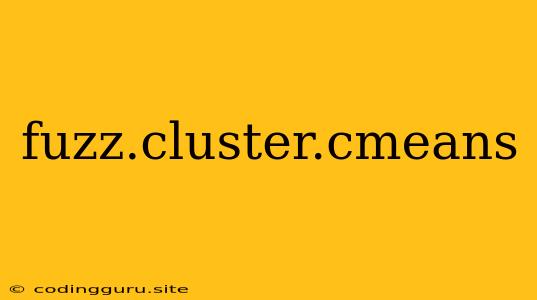Fuzzy C-Means Clustering: A Comprehensive Guide
Fuzzy C-Means Clustering (FCM) is a powerful data mining technique that extends the traditional hard clustering approach by allowing data points to belong to multiple clusters with varying degrees of membership. This concept of fuzziness is particularly valuable when dealing with complex datasets where clear-cut cluster boundaries are difficult to define.
Understanding Fuzzy C-Means Clustering
Imagine you have a dataset of fruits, with features like color, shape, and size. In a hard clustering method, each fruit would be assigned to a single category, like "apple" or "orange." However, with FCM, a fruit could be considered both "apple" and "orange," with different degrees of membership. This means a fruit might be 70% "apple" and 30% "orange," reflecting its characteristics closer to the "apple" cluster.
How does FCM work?
FCM works by minimizing an objective function that measures the distance between data points and cluster centroids. Each data point has a membership value to each cluster, ranging from 0 to 1, representing the degree of its belonging to that cluster. The algorithm iteratively updates both the membership values and the cluster centroids until convergence, meaning the memberships and centroids no longer change significantly.
Benefits of Fuzzy C-Means Clustering
- Handles overlapping data: Unlike traditional hard clustering, FCM can effectively handle datasets with overlapping clusters. This is crucial in many real-world applications where data points may exhibit characteristics of multiple clusters.
- Provides nuanced insights: By assigning degrees of membership, FCM offers richer insights into the data structure, highlighting the partial belonging of data points to different clusters.
- Robust to noise: FCM is less sensitive to noise and outliers than hard clustering, providing more stable and reliable results.
Steps Involved in Fuzzy C-Means Clustering:
- Initialize Parameters: You need to define the number of clusters (C) and the fuzzifier (m), a parameter that controls the fuzziness of the clusters.
- Assign Initial Membership Values: You can randomly assign initial membership values to each data point for each cluster.
- Calculate Cluster Centroids: Calculate the centroids for each cluster using the current membership values.
- Update Membership Values: Update the membership values based on the distance of each data point to the cluster centroids.
- Repeat Steps 3 and 4: Repeat steps 3 and 4 until the membership values and cluster centroids converge or a predefined termination criterion is met.
Practical Applications of FCM
FCM finds application in diverse domains, including:
- Image Segmentation: Segmenting images into meaningful regions based on pixel properties.
- Medical Diagnosis: Identifying disease patterns in medical data.
- Pattern Recognition: Classifying objects or patterns in complex datasets.
- Market Segmentation: Grouping customers based on their purchasing behavior.
Example: Fuzzy C-Means Clustering for Customer Segmentation
Let's say we have a dataset of customers with features like age, income, and purchase history. Applying FCM to this dataset can segment customers into different groups, such as "high-income young professionals," "middle-income families," and "low-income seniors," providing valuable insights for targeted marketing campaigns.
Considerations for Using FCM
- Choosing the Number of Clusters: Selecting the appropriate number of clusters is crucial for achieving meaningful results. Techniques like the Elbow method or silhouette analysis can help determine the optimal number of clusters.
- Fuzzifier Parameter (m): The value of the fuzzifier parameter (m) influences the degree of fuzziness. A higher value of m leads to more fuzziness, allowing data points to have higher degrees of membership to multiple clusters.
- Computational Cost: FCM can be computationally expensive, especially for large datasets. Efficient algorithms and optimization techniques are often employed to improve its efficiency.
Conclusion
Fuzzy C-Means Clustering is a powerful technique that allows data points to belong to multiple clusters with different degrees of membership. This provides a more nuanced understanding of data structure than traditional hard clustering methods. Its ability to handle overlapping data, provide robust insights, and deal with noise makes FCM a valuable tool for various applications in data mining, pattern recognition, and image processing.
